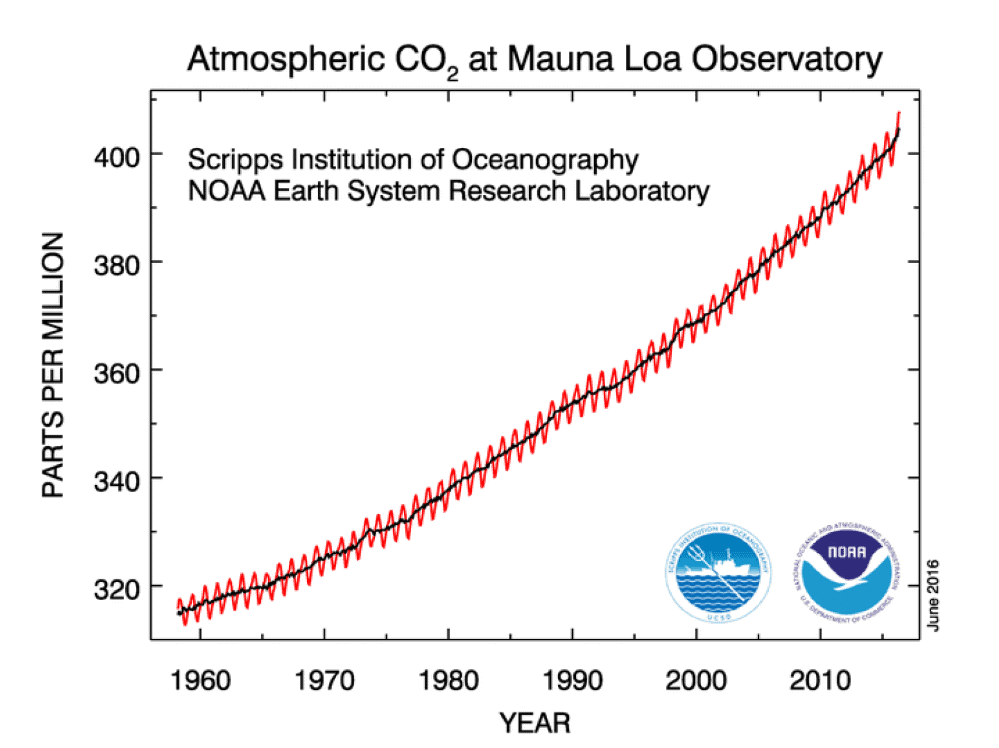An unusually strong El Niño has pushed an ignoble milestone for the world. The warm phase is rising CO2 concentrations in the atmosphere at the highest rate ever and scientists say there’s now no chance readings will fall below 400 parts per million (ppm) in our lifetimes.
In 2014, carbon dioxide levels reached 400ppm in the Northern Hemisphere for the first time in human history. Historically, however, CO2 in the atmosphere varies on a yearly basis slightly up or down, drawing a saw-tooth plot. But in 2016, El Niño will drive an increase of 3.15 ppm or one point above the 2.1 ppm baseline average.
“The atmospheric carbon dioxide concentration is rising year-on-year due to human emissions, but this year it is getting an extra boost due to the recent El Niño event – changes in the sea-surface temperature of the tropical Pacific Ocean. This warms and dries tropical ecosystems, reducing their uptake of carbon, and exacerbating forest fires. Since human emissions are now 25 percent greater than in the last big El Niño in 1997-98, this all adds up to a record CO2 rise this year,” said Richard Betts, of University of Exeter and lead author of the new study published in Nature Climate Change.
The first tab on CO2 concentrations in the atmosphere was made at a weather station at Hawaii’s Mauna Loa Observatory in 1958. Back then, CO2 in the atmosphere was 315ppm, and over the next 60 years it would steadily increase per the Keeling curve plotted below.

Plant growth varies with the seasons and cyclical weather patterns like the El Niño, which warms the central and eastern tropical Pacific, or its reverse, La Niña, which sustains a cooling of those same areas. Thus, during the summer CO2 levels are lower than in the autumn or winter.
At Mauna Loa, CO2 readings should have dropped below 400ppm in September if 2016 didn’t have an El Niño. Now, Betts and colleagues believe concentrations won’t drop below 400ppm ever again during our lifetimes.
This figure, 400ppm, doesn’t pose a scientific significance, but it’s a very disheartening symbolic milestone. That’s because the last time the planet had 400ppm was 3 million years ago. Prior to the industrial revolution, natural climate variations caused atmospheric CO2 to vary between about 200 ppm during ice ages and 300 ppm during the warmer periods between ice ages. At the dawn of the Industrial Revolution, around the year 1780, the CO2 concentration was about 280 ppm, so CO2 had already risen by around 40 ppm before Keeling began his measurements. Anyone who has breathed air with less than 300 ppm CO2 is now over 100 years old.
Our only shot to avert potentially catastrophic global warming once we pass the 500ppm threshold is to bring global emissions near zero as fast as possible, coupled with carbon negative technologies like carbon capture and sequestration. Stopping deforestation is one of the cheapest and readily available low-tech solutions at our disposal.
For now, 2016 will go in history as the first year carbon emission stay above 400ppm all year round. I don’t think anyone’s proud about this.



